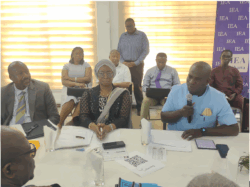By Benjamin Nathan OTCHERE
Ghana stands at a strategic juncture in its socio-economic evolution. With a burgeoning population, rapid urbanisation, and rising demands for infrastructure and employment opportunities, the need for innovative, locally-focused solutions is paramount.
This paper argues that sustainable development could be significantly enhanced through the aggregation of small contributions from citizens, starting with a nominal amount of one Ghana cedi per person.
Imagine a framework in which municipalities consolidate resources into a communal fund, subsequently generating returns to finance local initiatives aimed at addressing pressing community needs and fostering job creation.
This concept is both feasible and scalable, taking inspiration from successful implementations in various international contexts.
The Concept: Municipal Investment Development Fund
The underlying premise is straightforward yet transformative. Each resident within a municipality contributes a minimal monthly fee—ideally, one Ghana cedi—into a collectively managed investment fund.
The fund would be strategically deployed into low-risk, interest-bearing assets, with resulting returns allocated to crucial community projects encompassing infrastructure, employment initiatives, healthcare, and education. Over time, this fund’s compounded growth would yield a sustainable financial reservoir for local exigencies.
This model resembles sovereign wealth funds employed by nations for managing surplus resources but operates effectively at the municipal level. It enables local governance structures and residents to assume control of their developmental trajectory while embedding a culture of saving and investment.
Successful Global Precedents
Historically, community-based financial models worldwide have been influential in driving sustainable development. Great models have been successfully implemented in various parts of the world.
For example, in Brazil, the city of Curitiba established a municipal development fund that pooled resources from local taxes and citizen contributions.
The fund was used to finance public transportation, waste management, and urban planning projects, transforming Curitiba into one of the most sustainable cities in Latin America.
In India, the state of Kerala launched a community-based microfinance initiative called Kudumbashree, which encouraged women to contribute small amounts to a collective fund. The fund was used to start small businesses, build infrastructure, and provide social services, lifting thousands out of poverty and empowering local communities.
On a more localized scale in Africa, nations such as Kenya and South Africa have pioneered community savings schemes to finance local projects.
The Harambee system in Kenya stands out for its community-initiated funding of educational and infrastructural projects, while South African stokvels serve as community savings collectives that support members and facilitate funding for community development.
Ghana, drawing from its rich heritage of communal contributions—evident in traditional practices like “nnoboa” within agricultural communities—can modernize and adapt these frameworks to fit its unique socio-economic landscape.
These case studies illustrate that when communities collaborate to pool resources, they can achieve significant developmental outcomes.
Scenario Analysis: One Cedi, One Community, One Future
To elucidate the potential impact of this initiative, consider the Ledzokuku Municipal Assembly (LeKMA), with a population of 217,304 residents (2021 Population and Housing Census).
If each individual contributes one Ghana cedi monthly, the municipality would accumulate approximately GH¢ 217,304 per month. Over a five-year horizon, this equates to GH¢ 13,038,240, exclusive of accrued interest.
Assuming prudent fund management and investment in low-risk instruments such as treasury bills, government bonds, and bank securities, one could assume an average annual return of around 12%.
By the end of Year 5, the fund could potentially expand to about GH¢ 18 million, establishing a consistent funding source for community projects. This could also mitigate the financial burden on the government to contribute annually to the District Assembly Common Fund (DACF).
Interest earnings from a reinvested principal of around GH¢ 18 million could be allocated to various beneficial socio-economic initiatives, including:
Infrastructure Development: Investing in critical infrastructure such as roads, bridges, and drainage systems to enhance connectivity and mitigate flooding.
Job Creation: Financing vocational training programs and small business incentives to address unemployment rates.
Healthcare and Education: Constructing clinics, schools, and libraries to bolster access to essential services.
Environmental Sustainability: Focusing on waste management and renewable energy projects to promote a cleaner, more sustainable community.
The ramifications of such investments would be transformative, significantly elevating the quality of life among residents and stimulating local economic activities.

Auxiliary Benefit: Strengthening the financial sector
Furthermore, a municipal investment development fund could significantly fortify Ghana’s financial sector. By aggregating resources and channeling them into secure investments, the fund would create an auxiliary source of capital for local banks and financial institutions. This influx of capital can potentially decrease borrowing costs and enhance credit accessibility for enterprises and individuals.
Additionally, the fund could serve as a catalyst for financial education initiatives, imparting knowledge about the significance of savings, investments, and sound financial planning. Over time, these efforts could cultivate a more financially literate populace and contribute to a more resilient financial sector in Ghana.
A Call to Action: A possible local development strategy
In conclusion, the establishment of municipal investment development funds can represent a pivotal opportunity for Ghanaian local governments and communities to harness collective resources for sustainable development solutions.
Engaging stakeholders, including government agencies, community leaders, and financial institutions, will be critical to realize this vision effectively. By fostering a participatory approach to financial and resource pooling, Ghana can strategically navigate its developmental challenges and create impactful change at the local level.
The writer is a Certified Financial Advisor and Planner










